Train travel in India: A step-by-step guide
As I mentioned in my recent post about traveling in India with ADHD, I booked all of our train tickets for our two-month trip well ahead of time. In this article, I’ll go over what I learned: how to book the tickets, which tickets to book, what to do at the station to find your train and your seats, and what you can expect from train travel in India.
Disclosure: This article contains affiliate links. Making a purchase through an affiliate link will mean a small commission for this website. This will not affect your price.
TL;DR
- Use 12Go to book your train. Consider timing, location and seat class.
- You can book chair cars or sleeper cars, day or night.
- There are generally 3 classes: first, second and third. First and second don’t differ much.
- Your ticket has your train number, wagon number and seat number:
- At the station, use the train number to read the digital board to learn what platform you should go to.
- On the platform, use the wagon number to see where your wagon will be for you to board.
- Use your seat number to check the information on the train wagon, then find your seat.
- Use the Table of Contents below to jump to whatever you want more information about.
But first, a disclaimer: I’m not an expert on either travel in India in general or Indian trains in particular. I’m just going to include what I learned over the two months my husband and I traveled by train around Madhya Pradesh, Uttar Pradesh and Rajasthan. It came to nine different trips ranging from four hours long to about 13 hours long. Most of them took longer than advertised, by anywhere from a half hour to three or four hours.
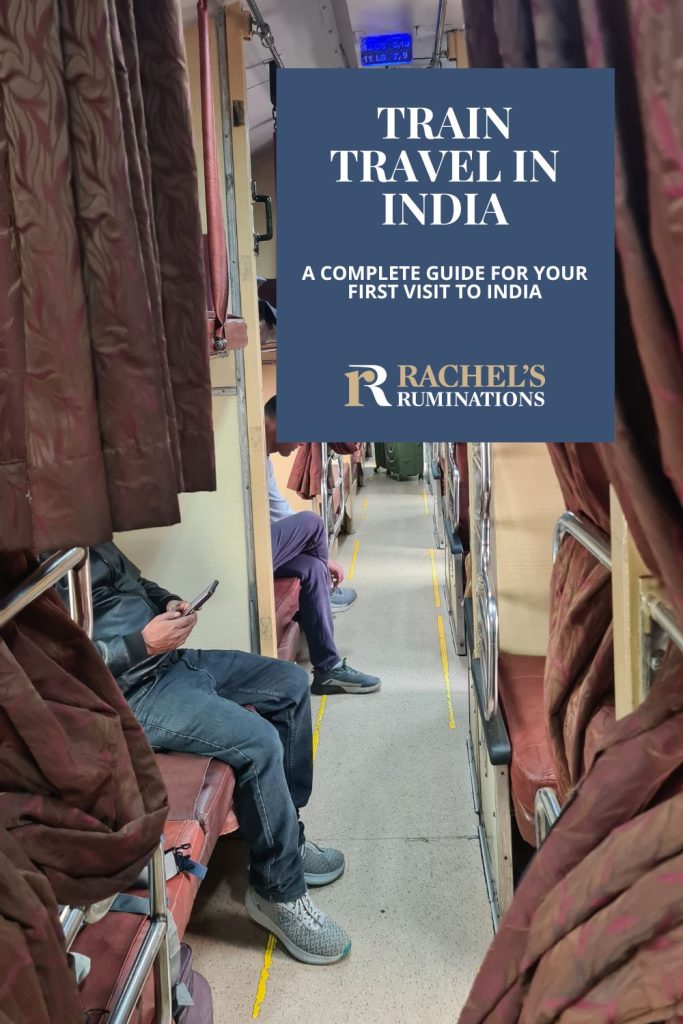
As an aside, many of these routes could be done by plane for a price similar to the price of a first-class train journey. We chose not to. My husband has decided that he only wants to fly once a year for environmental reasons. Flying to and from India is all the flying he intends to do this year. I haven’t made the same resolution, but I have been avoiding flying whenever I have a more environmentally-friendly option. So we booked trains.
Step 1: Booking your train trip
If you live in India, you can very easily go on the Indian Railways website and book your trips. From outside the country, that does not appear to be possible. Believe me: I tried! A VPN, incognito mode … nothing worked.
One option is to go through an Indian travel agency. Give them your dates and requirements well ahead of time and they’ll book them for you. First-class tickets get bought up very quickly once they are released two months before the travel date, so the timing is important. (More about classes below.)
I reached out to an Indian travel agency, but didn’t take this option. The prices quoted were so significantly higher than the prices I could see on the Indian Railway website that I decided to find another way.
Using 12Go
Note: My links here to 12Go are affiliate links, so I will earn a commission if you use them, but please understand that this article is not intended as an ad. I really did buy my train tickets on the website 12Go. I had used 12Go in 2024 on our two-month trip to Thailand and Cambodia, so I already knew it was legit.
12Go does, of course, add a booking fee, and it’s significant. But it was less than the travel agent in India quoted, and I prefer to make reservations myself. The percentage seems to vary, but I’ll give one example. A 12-hour trip from Jaipur to Jaisalmer in a first-class sleeper cost 4,890 rupees for the two of us. That’s about 50 euros. The booking fee was 896 rupees or about 9 euros.
It’s very simple to use. Enter the date you want to travel and how many passengers you’re booking for, and it’ll show a list of ways to get there. With bigger cities like we were planning to visit, it showed options and prices for flights, trains, buses and taxis. If you specifically want one mode of transportation, you can filter out the others.
So, presented with a list of different trains that ran the route I wanted on the date that I wanted, I looked at three things in particular: timing, location and seat class.
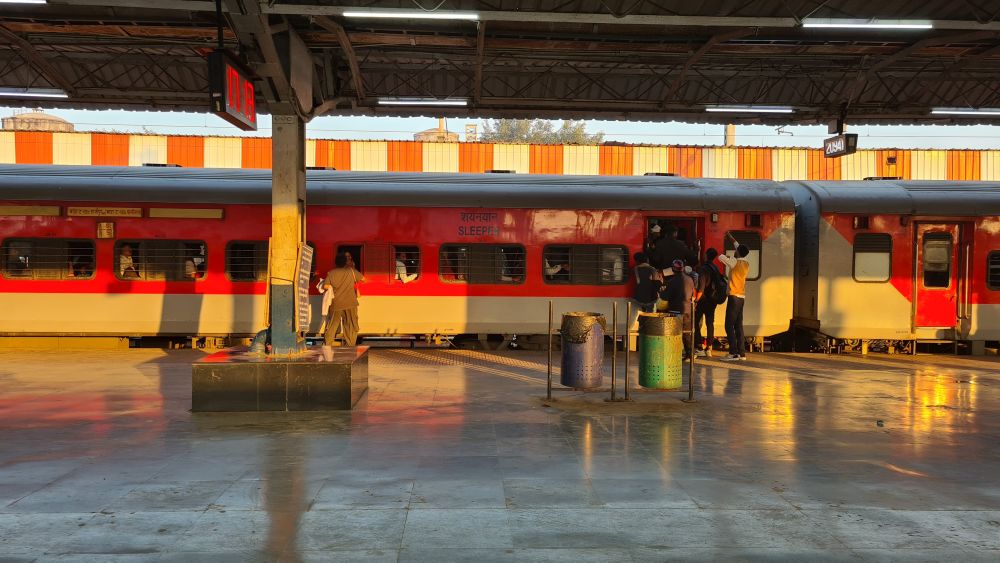
Timing
Many of these trains go extremely long distances. They might, for example, leave from Delhi and go all the way to Bangalore in the south. It could take several days. That means that trains could pass through a station at any time of the day or night.
Looking at the train times, I could choose one that left at a time of day that would work best for me. For shorter journeys I mostly chose day trips, but for longer ones, I chose night trains, where I could – theoretically at least – sleep. In that case I’d want to check what time it arrives at my destination – too early and I’d be miserable.
The point is: take a good look at the timing to make sure it’s something you can handle without too much stress.
And a tip: Don’t panic if the Indian Railways ticket says, say, 3:30, when it means 15:30. You’ll see that 12Go includes a separate itinerary that has the correct times on it. If you want reassurance, plug the train number into the Indian Railways Reserved Train Schedule page and you’ll see the schedule.
Location
Sometimes the list of options would include trains departing from other stations that had different names. So, for example, Agra has two main train stations – Agra Fort and Agra Cantt. There’s also one outside of the city called Tundla Junction. I looked them all up on Google maps to make sure, when I booked our train to Agra, that arriving at Tundla Junction wouldn’t be a problem. It wasn’t wonderfully convenient, but the timing suited us. From there we could either take a local train into the city or a taxi.
Use a map app to look up the other options that 12Go offers for your search so you can make sure they’re near where you want to go. They might or might not be convenient for you.
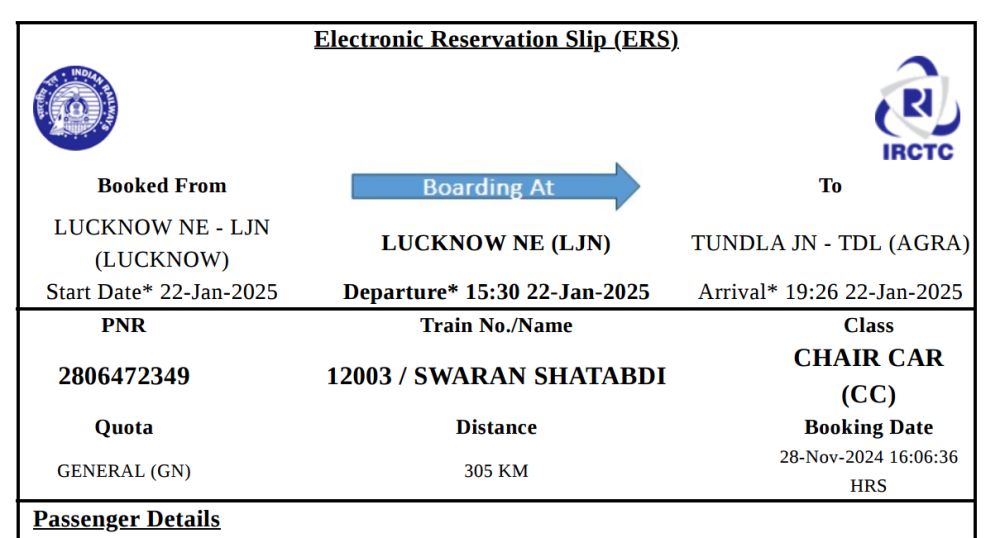
Seat class
I’ll get into this more below, but I knew already that I wanted to travel in either second or first class. First class was often already booked up, in which case I’d choose second. If only third class was available, I’d search on a different day. In one case, I couldn’t find anything other than third class even on subsequent days, so I booked a bus instead. In the one case when none of the options worked for me, I ended up buying a ticket from a travel agent after we arrived in India. They know more about alternative possible routes and seem to have ways to get tickets that don’t show up on 12Go.
So you choose your tickets and pay for them. 12Go sends you a receipt immediately and either a ticket – an official Indian Railways ticket – or a message saying that they’ll send your ticket when it’s available. This made me nervous, of course, but I realized that since Indian Railways doesn’t release tickets until two months before travel, it made sense. Sure enough, a couple of days after that two-month mark, I’d receive an email with the actual ticket.
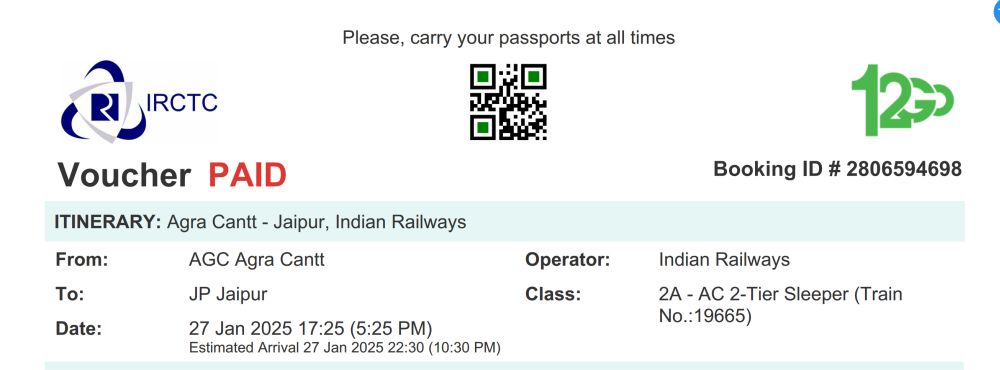
Classes on Indian trains
There are basically three classes: first, second and third, though third seems to sometimes get called “general.”
Third class
These tickets are extremely cheap, which is why third class, as far as I could see, is always extremely crowded. I never traveled third class, but there don’t seem to be any assigned seats there. Sometimes they only have fans for ventilation, while sometimes they have air-conditioning.
What I can tell you is that when they’re crowded, the third-class wagons can get scary. At one station, we’d arrived early and were killing time on Platform 1, the platform right next to the train station building. There were lots of people waiting, and when the train pulled up, it was like a riot broke out.
People surged toward the doors of the wagons, completely blocking the doors so the people who wanted to get out had to push – hard! – to get through.
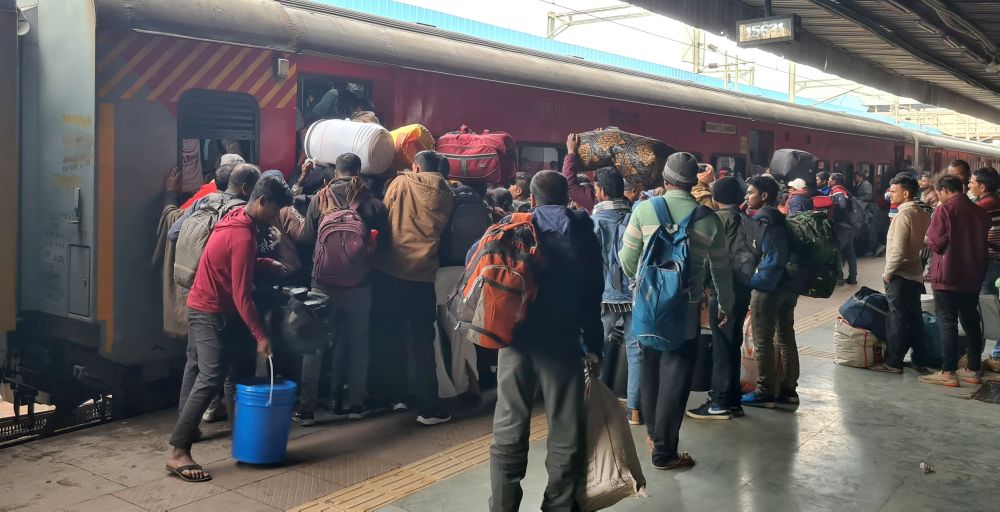
The crowd pushed at each door trying to get in. People held their luggage over their heads, tossing it ahead of them into the car right on top of other people. Others tried – and often succeeded – in pulling themselves up and climbing in via windows. From what I could see, every available inch of space inside was packed, yet more people were trying to push themselves inside.
At one point, a fight broke out. Someone who had managed to get in, but was still in the doorway, shoved hard one of the people pushing in. He landed on the platform on his back. By the time he got up, the one who pushed him jumped back out of the train wagon and punched him. Several other people then pulled them apart. Then they all turned back to pushing into the train.
It wasn’t pretty. And I was so grateful not to have to enter the fray. As the train slowly pulled out of the station, people ran alongside it, still hoping to find a door with room enough to jump in. And all the third-class doors were open, with people standing in the openings, half out and half in, hanging on with one hand.
First and second class
In second and first class, you get an assigned seat, so there’s no rush to get on and it’s not overcrowded.
There are different sorts of seats. You can book “chair class,” which is most like what we’re used to in the west: rows of seats. Sometimes it’s called “second-class seats.” If it’s a warm time of year or a warm part of the country, make sure to look for “AC” – air conditioning.
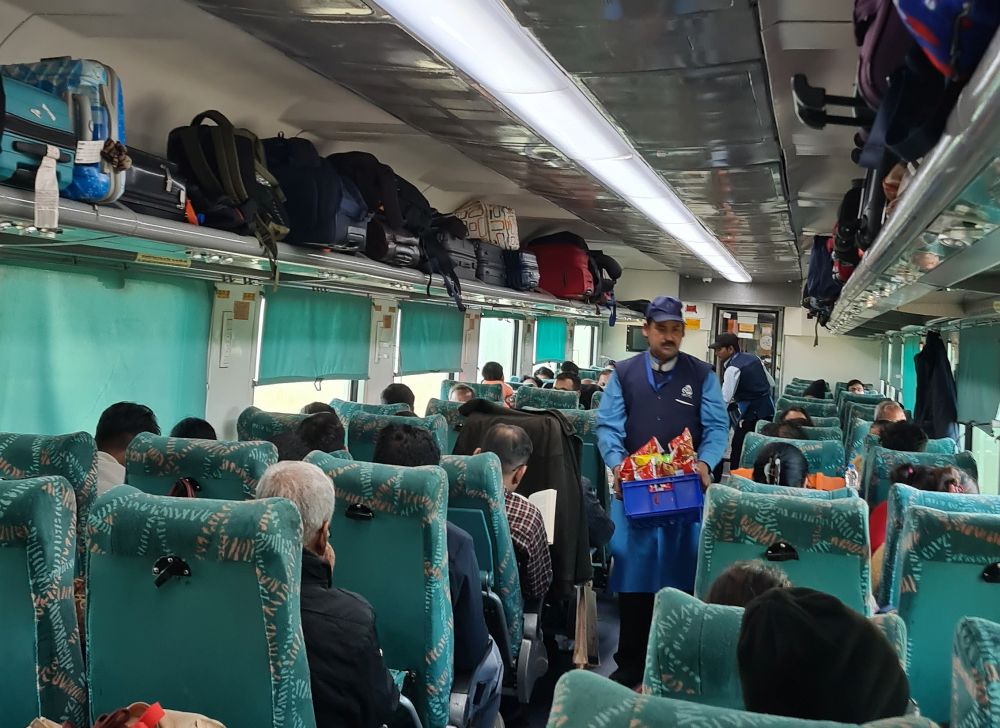
Otherwise, you’ll be booking sleepers. Even for day trips, these are listed as sleepers. And when you find your compartment, there may very well be people asleep in it: remember that sometimes the train may have come from very far away.
Again, make sure they are marked on 12Go as having AC. (As far as I could see, second-class as well as first class always has AC. I wouldn’t swear to it, though, so check it when you choose your seats.)
What the sleeper cars look like
First-class sleeper compartments hold either two or four people, but they’re all listed as “four-tier.” You can’t choose a compartment for two people; it’s just the luck of the draw. We got a compartment for two only on one of our trips. (My guess is that if we both had the same last name our chances would have been better.) The aisle is along one side of the train and the compartments all open from the aisle.
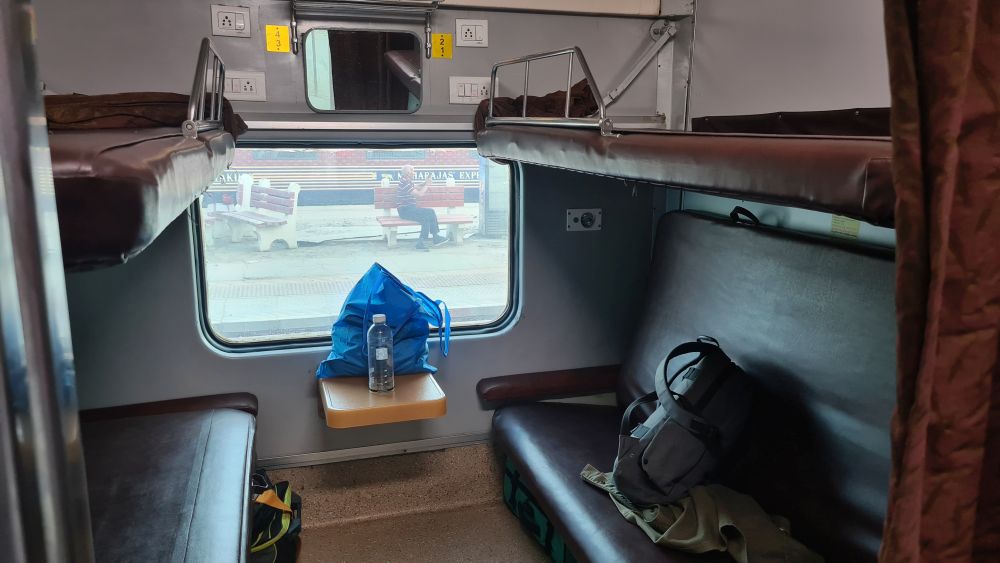
Second-class sleepers are listed as two-tier or three-tier. They’re configured differently from first class. The aisle goes along between bunks on both sides of the train. On one side are bunks for two or three people, one above the other (lying parallel to the direction of travel). On the other side are the compartments. Each compartment holds either four or six people (in bunks of two or three) intersecting the direction of travel.
This means that the first-class compartments are bigger, but that doesn’t mean the bunks are bigger. It means the ladders to the upper bunks are inside the compartment. In second-class, the ladders edge the aisle, so you climb up in the aisle space.

I would suggest always booking bottom bunks if you’re traveling during the day. The reason for this is that you can fold the bottom bunks up against the wall to create regular bench seats. If you’ve booked a top bunk, you might have to sit up there for the whole ride if the people in the bottom bunks want to sleep.
If you’re traveling at night, the top bunks are probably the better choice, mostly because your belongings will be safer there. You can tuck them away where random thieves can’t reach them. We slept on the bottom bunks, and I ended up sleeping with my backpack next to me – it contained my laptop and camera. Given my size, that wasn’t particularly comfortable.
What’s the difference between first and second class in Indian trains?
In our experience, there isn’t much difference. In first class, though, the doors to the compartments are real doors: you can close and even lock them. Of course, if you’re sharing with strangers, you’ll have to talk to them about locking. The compartment may be a bit wider in first class, which would make the bunks slightly wider, but if so, it’s only a very small difference.
In second class, only curtains separate the compartments from the aisle (see photo above). That means anyone can peek inside and, if you’re not careful, anyone can take your things. It also means when hawkers walk up and down the aisles selling food, you’ll hear them. The first-class doors block some of the noise.
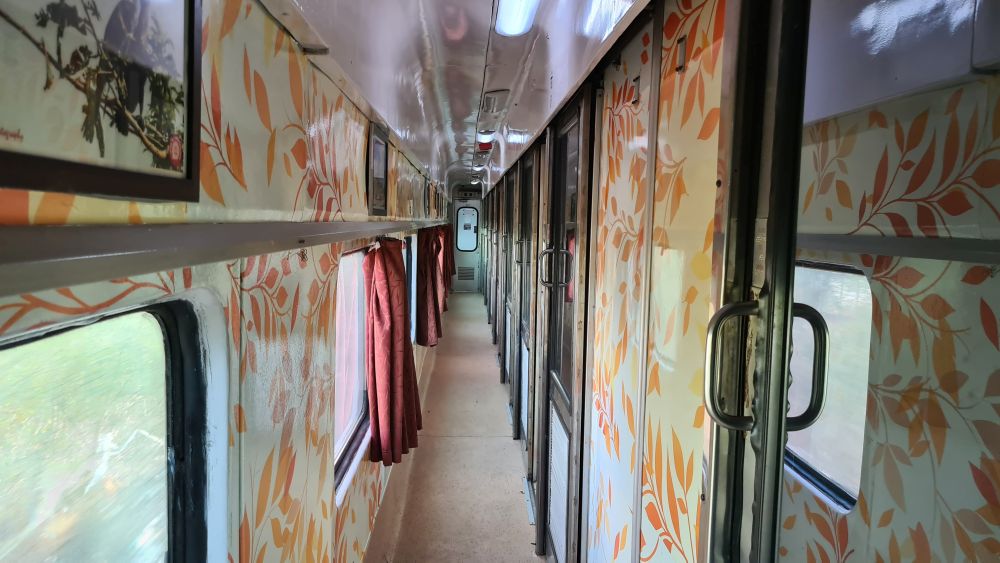
In both classes, you can’t expect any kind of luxury. In the evening, a steward will issue you with clean sheets and a small towel in a paper package, and you make your “bed” yourself. (If the sheets have been used by the time you board, or you just don’t get any, you can usually find the steward at one end of the wagon or the other.) You’ll also receive a small pillow and a blanket. The bunks are very hard and not very wide. I did not sleep at all well.
In some trains, the windows were more or less transparent, but generally quite scratched and dirty. In one compartment we traveled in, the window let in some light, but was so damaged we couldn’t see out of it at all. The curtains in front of the window are generally very old and dirty and sometimes I couldn’t slide them as intended. We could not open the window on any of our train journeys, but the AC kept it comfortable.
Each bunk has a small wall light, which may or may not work. If you are in a top bunk, there’s an electrical outlet within reach above the window, which, again, may or may not work.
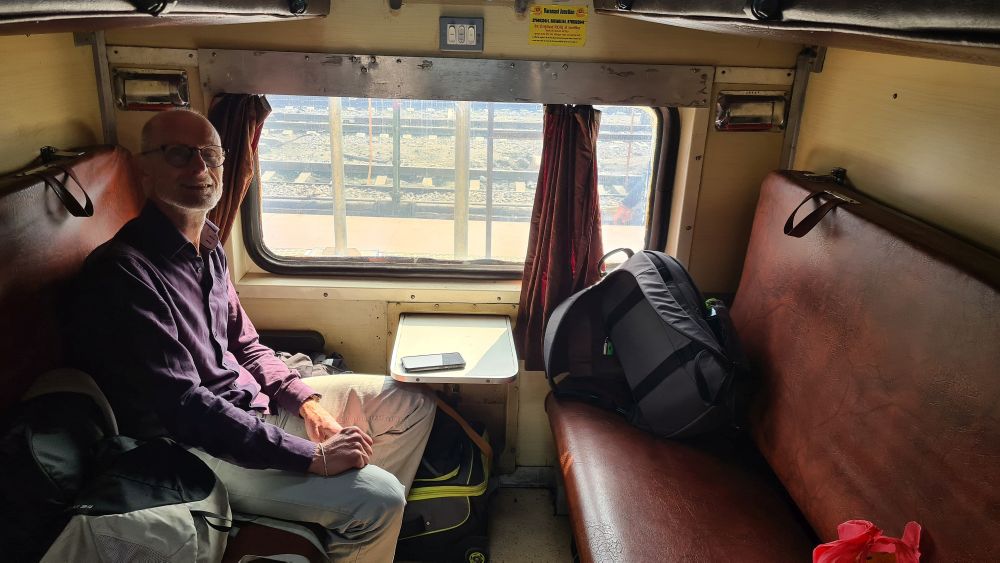
We found the Indian trains just plain dingy – not dirty, really, but rundown. They’re decades old and haven’t had a refurb since they were built, I’m sure. As for the bathrooms – at both ends of the car in both first and second class – I’ll leave them to your imagination. I’ll just say it’s not at all pleasant.
Indian Railway tickets include the statement “IR recovers only 57% of cost of travel on an average.” If that’s true, it’s not surprising the trains don’t get renovated. The costs of running a train system to serve almost 1.5 billion people must be astronomical!
On the other hand, the temperature was always comfortable. Sometimes there are switches to control the air conditioning and/or the fan.
I should add that there may very well be some more modern trains in India. I’m just basing my assessment on the nine train trips we took.
When you buy your tickets for a second-class sleeper or chair car, you’ll get your wagon and seat number on the ticket (more on those below). If you opt for first class, your seat assignments will not be released until four hours before the journey. You can look it up on the Indian Railways website by typing in your PNR (passenger number, which you’ll find on the ticket) here.
As you’re planning your trip to India, you might also want to read these articles:
Step 2: At the station
The train stations, in our limited experience, are loud, chaotic places. However, the trains are actually pretty well-organized. Here’s what to do:
Finding your platform
There’s an electronic board showing all expected trains and what platform they’ll be at, e.g. “PF 2.” Sometimes it lists the trains’ names, but sometimes it just shows their numbers: you can find the name and number on your ticket. So, for example, from Delhi Nizamuddin station, we took the train number 12650 with the name “Ypr Sampark KRT.” You can also show your ticket at a ticket booth and they’ll tell you.
In the more modern stations like Agra Cantt, there are monitors along the platforms as well that list the day’s trains.
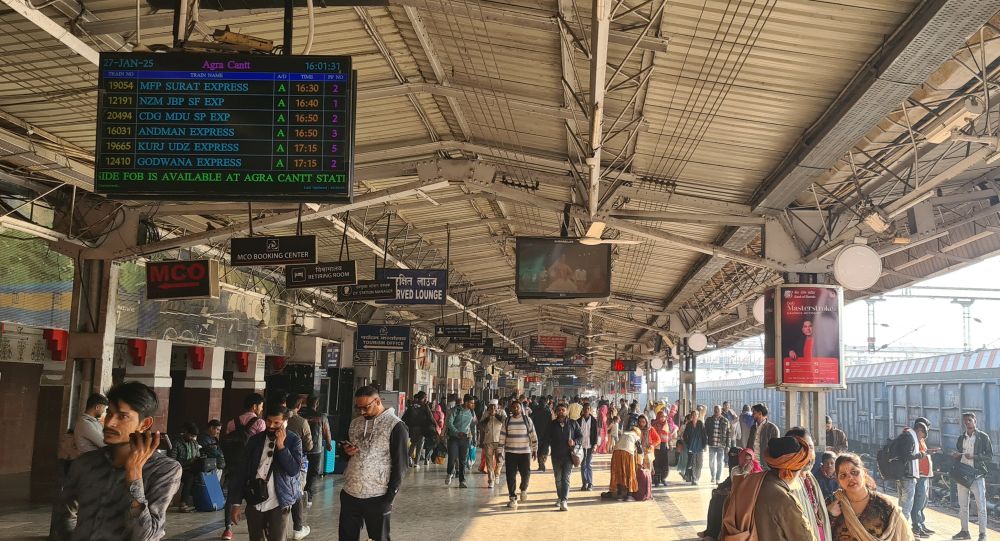
Finding your train is usually just a matter of signage, but on one trip, from Bhopal to Khajuraho, our train wasn’t on the board. I went and showed my ticket to a woman at a ticket booth, and she directed me to the other station. Other station? It turns out that there are two train stations right next to each other: Bhopal and Bhopal Junction. We were waiting at the wrong one. Fortunately, we’d arrived early enough for this not to be a problem.
Be aware that the bigger Indian cities have absolutely enormous train stations. You may not be able to find the electronic board. If you want to ask a question, you may not be able to find the ticket window. That’s because the station could have two or more station halls. If you can’t find what you’re looking for in the station hall where you entered, walk along the nearest platform and you’ll find the next station hall.
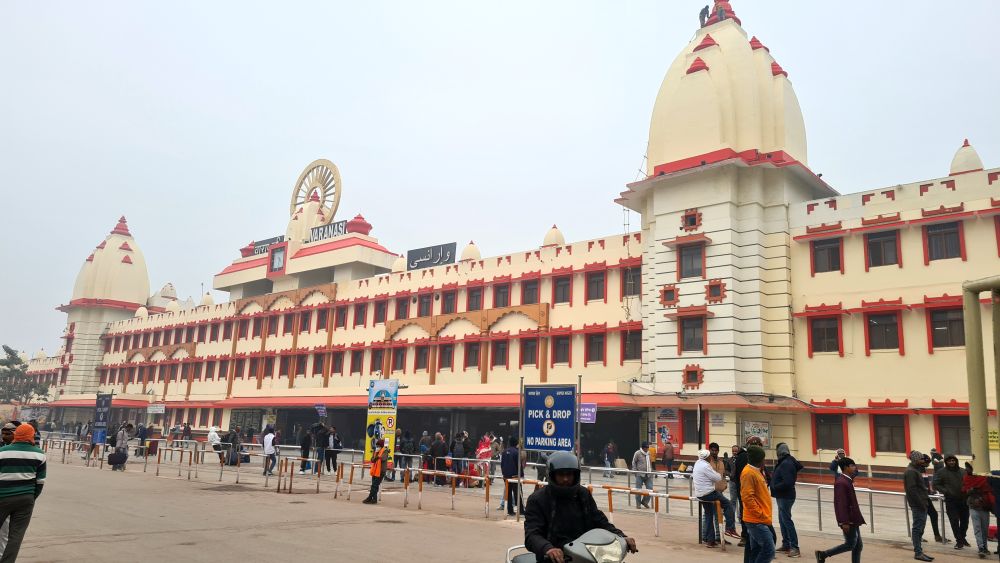
In addition, a recorded voice over a loudspeaker repeatedly announces arrivals of trains in English, starting long before they arrive. We found that very useful, so we made sure to wait somewhere we could hear that voice clearly – usually outside on a platform is better than inside a station hall. Once the train is nearing the station, it’ll repeat the announcement over and over.
Our tickets came with additional pages added by 12Go, and I think one particular part is worth quoting: “Please beware of scammers! Do not believe strangers (even if they are in uniform), and show your ticket only to the conductor inside the train. Common scams: your ticket quota is for Indians only, your train has departed/ delayed/ canceled, etc., and then they will offer you a taxi.” The messages on the loudspeaker will tell you if your train is delayed and by how much, so trust them rather than any random person who approaches you.
Step 3: On the platform
Once you know what platform you need to be at, go there. Long before the train arrives, the train number will appear on digital signs all along the track, so you’ll know you’re in the right place. Don’t panic if it’s late, but again, ask someone official if you’re unsure.
Finding your assigned wagon
You need to know ahead of time which wagon your reserved seat or bunk is in. If you’re traveling second class, your ticket will say something like A1 or H2, followed by your seat number. If you’re in first class, you should check within four hours of departure on the Indian Railway site to get your wagon and seat number. This is what I did and it was easy enough to fill in the PNR and get the information. You can also check in the station hall. There, you might be able to find a hand-written list of names with their corresponding wagon and seat numbers. Otherwise, ask at the ticket booth.
When the train’s arrival is imminent, the digital signs along the track will start showing those wagon numbers. Go to yours, because you really don’t want to have to move down the train aisles from car to car! Especially third class would be near impossible to pass through.
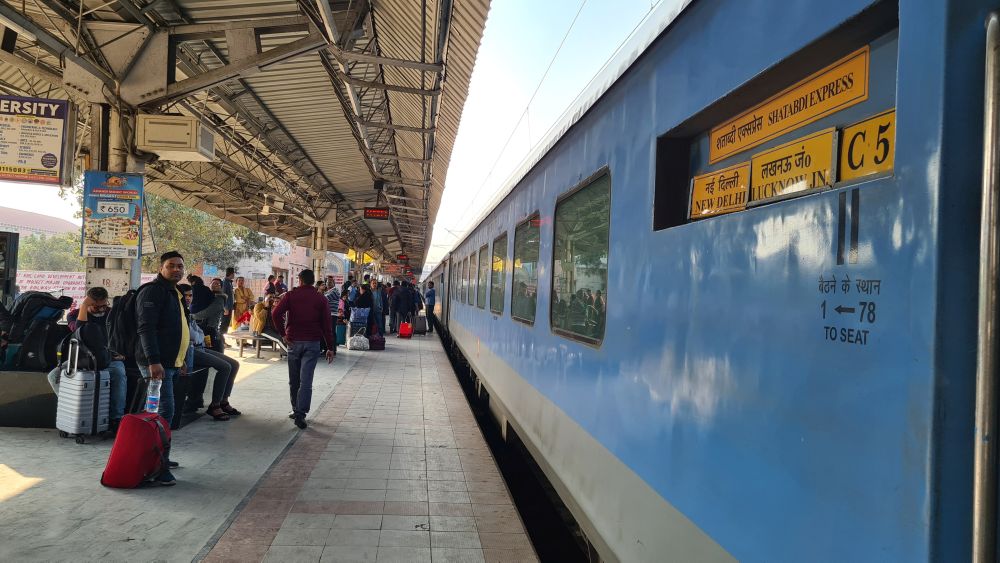
When the train finally stops – these are very long trains! – the wagon numbers showing on the platform will line up with the corresponding wagon. So the B2 train car will stop more or less where the B2 sign shines on the platform.
As the train comes in, look at the middle of each train car. That’s usually where you can spot the number of the car.
Finding your seat or bunk
Next, look at your ticket to see what seat you’ve been assigned. After the wagon number you’ll find the seat number, so the whole thing will say something like CNF/A1/25/lower. (CNF means confirmed, I think. Train car A1, bunk 25, lower bunk.)
At both ends of the car by the door is an indicator of the seat numbers, so it’ll say, for example 1-78, as in the photo above. If your seat number is low, enter at the far end. If it’s nearer 78, enter at this door.
Step 4: In the train
Find your seat or bunk and settle in! If it’s evening or early morning, try to keep the noise down because people might be sleeping.
We stored our luggage under the seats, pushed as far back as possible. So did the Indians who shared our compartments each time. I’ve heard of people locking their luggage to the seat with a chain they brought along, and I brought a small one to do the same, but never really felt the need. I just kept my backpack – which had all my most important and valuable things – with me in bed when I slept.
Since these trains cover such long distances, it’s possible, perhaps likely, that you won’t arrive at the scheduled time. You will get there, though, so just relax. Read a book, look out the window, or sleep. I noticed as well that they often make up some of the delay as they go, presumably by moving a bit faster between stations.
Keeping track of your journey
The schedules for all trains are published on the Indian Railways site under “Reserved Train Schedule,” right down to how long the train will stop at each station. Check your train route by typing in the train number and note how long the train will stop at your destination. If it’s a short stop, make sure you’re ready and near the door when it’s time to get off. If it’s a longer stop, you can take your time.
You can find out how delayed the train is on the website Running Status. Just type the train number in the space at the top and the date and it’ll tell you its whole schedule, with its delay, if any, at every station.
If you arranged a taxi pick-up ahead of time, or a hotel is providing transport, make sure they know what train you’re arriving on. They’ll know how to look it up and see how delayed it is.
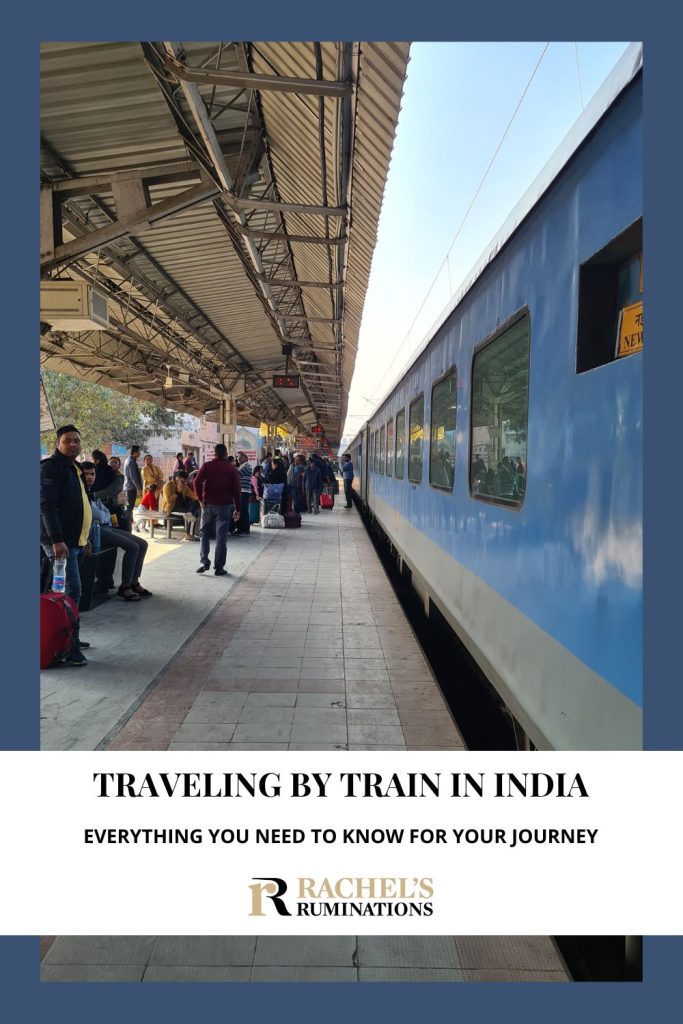
Some general tips
Things to bring along on the journey
Food and water. A travel agent in India warned us not to eat the food sold on the train, so we bought packaged food and peelable fruit to take along, as well as some bottled water. My husband drank some chai sometimes and didn’t get sick from it, but I didn’t dare. Take more food than you’ll need in case the train has a significant delay.
A powerbank. The outlets don’t always work, and if you’re on the bottom bunk the people in the top bunk might commandeer the outlets. A powerbank is a good backup.
Toilet paper, hand sanitizer and a toilet seat cover. As I mentioned above, the toilets are pretty consistently awful. There’s usually both a sit toilet and a squat toilet opposite each other at each end of the wagon. Bring toilet paper in case there isn’t any. There is water to wash, but hand sanitizer is a good idea in general. And a toilet seat cover might be wise too. Or use the squat toilet option to avoid touching anything.
Cloth or wipes. You could also bring some sort of cloth for cleaning the window. If your compartment is on the platform side of the train, and you have time before the train leaves (or at a station with a longer stop), you could hop out and clean the glass.
Other tips
What to wear. Unless you have a compartment to yourself – and you won’t know that until you get on the train – you won’t get an opportunity to change into pajamas. Just dress in clothes that will be comfortable to sleep in.
Taking pictures. Don’t expect to take good pictures out the train window because of the dirt and scratches. I noticed, though, that sometimes the exit doors at the ends of each carriage are open – I think you can just open them as the train moves. Be careful, of course, but standing at the train door would allow some better pictures.
When you arrive. When you arrive and get off the train, be prepared for the onslaught of hawkers trying to lure you to taxis or tuk-tuks (often called rickshaws). Have a clear idea of what you want to do and just ignore them, unless you need them. If you do need a ride, make sure to agree a price before you get into the vehicle, making clear whether the price you’ve agreed is per person or for you and your travel partner(s) together.
Take the metro. In places with a metro system, like Delhi, Agra, Jaipur or, I presume, many other cities, I recommend taking the metro whenever you can. Figure out ahead of time which stop is nearest to your hotel, then take a tuk-tuk or taxi from there, if necessary. The metros are, of course, environmentally-friendly, but they’re also quicker, more comfortable, quieter and much cheaper than tuk-tuks, taxis or buses.
Have I missed anything? Do you still have questions? Feel free to comment below with your questions!
My travel recommendations
Planning travel
- Skyscanner is where I always start my flight searches.
- Booking.com is the company I use most for finding accommodations. If you prefer, Expedia offers more or less the same.
- Discover Cars offers an easy way to compare prices from all of the major car-rental companies in one place.
- Use Viator or GetYourGuide to find walking tours, day tours, airport pickups, city cards, tickets and whatever else you need at your destination.
- Bookmundi is great when you’re looking for a longer tour of a few days to a few weeks, private or with a group, pretty much anywhere in the world. Lots of different tour companies list their tours here, so you can comparison shop.
- GetTransfer is the place to book your airport-to-hotel transfers (and vice-versa). It’s so reassuring to have this all set up and paid for ahead of time, rather than having to make decisions after a long, tiring flight!
- Buy a GoCity Pass when you’re planning to do a lot of sightseeing on a city trip. It can save you a lot on admissions to museums and other attractions in big cities like New York and Amsterdam.
Other travel-related items
- It’s really awkward to have to rely on WIFI when you travel overseas. I’ve tried several e-sim cards, and GigSky’s e-sim was the one that was easiest to activate and use. You buy it through their app and activate it when you need it. Use the code RACHEL10 to get a 10% discount!
- Another option I just recently tried for the first time is a portable wifi modem by WifiCandy. It supports up to 8 devices and you just carry it along in your pocket or bag! If you’re traveling with a family or group, it might end up cheaper to use than an e-sim. Use the code RACHELSRUMINATIONS for a 10% discount.
- I’m a fan of SCOTTeVEST’s jackets and vests because when I wear one, I don’t have to carry a handbag. I feel like all my stuff is safer when I travel because it’s in inside pockets close to my body.
- I use ExpressVPN on my phone and laptop when I travel. It keeps me safe from hackers when I use public or hotel wifi.





